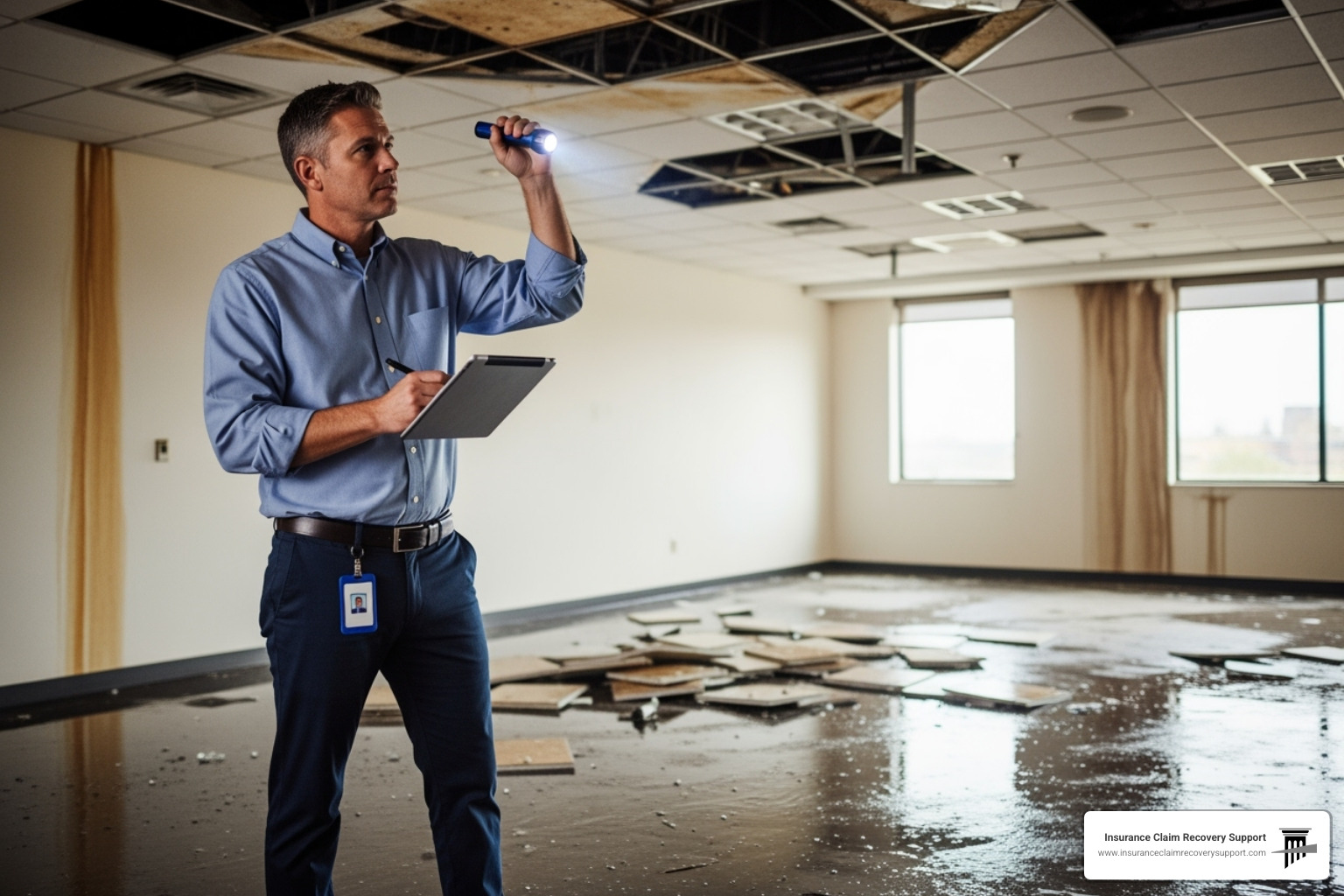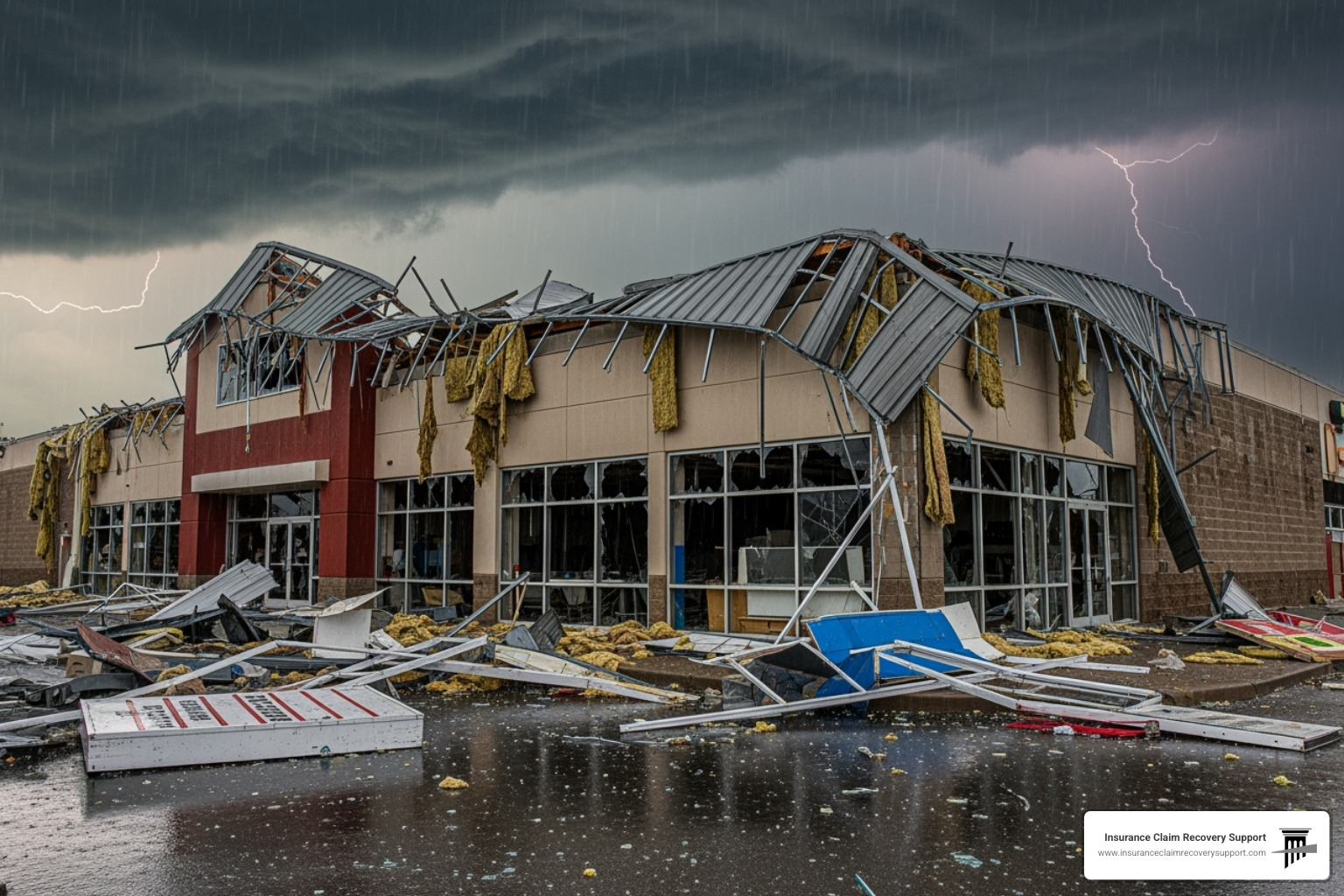Making Roofing Insurance Claims for Storm Damage Simple

Roofing insurance claims for storm damage can be overwhelming, especially if it’s your first time dealing with such an issue. Here’s a quick guide to get you started:
- Inspect Your Roof: Look for missing or damaged shingles, leaks, or other visible damage.
- Document Everything: Take photos and videos of the damage.
- Check Your Insurance Policy: Understand what is covered and whether you have an Actual Cash Value (ACV) or Replacement Cost Value (RCV) policy.
- File a Claim: Contact your insurance provider and start the claim process.
- Hire Reputable Contractors: Ensure you choose experienced and reputable roofing contractors.
Dealing with storm damage is stressful, but knowing the basics of handling roofing insurance claims for storm damage can make things easier.
Hello! I’m Scott Friedson, a Multi-State Licensed Public Adjuster. With over 30 years of experience and hundreds of large loss claims settled, I’m here to help you steer the insurance process and ensure you receive the settlement you deserve for your roof storm damage.

Similar topics to roofing insurance claims for storm damage:
– denied storm damage insurance claim
– hail damage roof replacement
– how to file an insurance claim for storm damage
Navigating roofing insurance claims for storm damage can seem daunting, but understanding the basics can make the process smoother. Let’s break down the key elements you need to know.
Types of Storm Damage Covered
Storms can wreak havoc on your roof, and different types of damage may be covered by your insurance policy. Here are the common types of storm damage typically covered:
- Wind Damage: Strong winds can lift, curl, or completely remove shingles, exposing your roof to further damage.
- Hail Damage: Hailstones can dent metal surfaces, crack shingles, and cause granule loss.
- Fallen Trees: Trees or large branches can fall on your roof, causing significant structural damage.
- Heavy Rain: Prolonged rain can lead to leaks and water damage, especially if your roof is already compromised.
- Snow: Heavy snow can add excessive weight, leading to leaks, damp rafters, or even roof collapse.
Understanding these types of damage helps you know what to look for and what to document when filing a claim.
Reviewing Your Insurance Policy
Before filing a claim, it’s crucial to review your insurance policy. This will help you understand what’s covered and what isn’t. Here are the key elements to focus on:
- Actual Cash Value (ACV) vs. Replacement Cost Value (RCV):
- ACV: This policy type gives you the depreciated value of your roof. You receive a one-time payment based on the current value of your roof, which may not cover the full replacement cost.
RCV: This policy covers the cost to replace your roof with a new one. Initially, you get a check for the ACV, and once the replacement is complete and proof is provided, you receive a second check for the remaining amount.
Policy Exclusions: Some policies have exclusions for certain types of damage. For instance, cosmetic damage or damage due to neglect might not be covered. Always check for exclusions to avoid surprises.
Deductible: This is the amount you pay out of pocket before your insurance kicks in. Be aware of your deductible amount, as it affects your final payout.
Case Study:
A homeowner in Nashville, Tennessee, experienced severe wind damage to their roof. They had an RCV policy, which initially provided the depreciated value. After the roof replacement was completed and documented, the insurance company released the remaining funds, covering the full cost except for the deductible.
By understanding these elements, you can better prepare for the claim process and ensure you receive the appropriate compensation for your roof damage.

Next, we’ll dive into the steps to file a roofing insurance claim, ensuring you have all the information you need to steer the process confidently.
Steps to File a Roofing Insurance Claim
Filing a roofing insurance claim for storm damage involves several key steps. Let’s break them down to make the process as smooth as possible.
Documenting the Damage
The first step in filing a claim is to document the damage thoroughly. This helps provide proof to your insurance company.
Take Photos and Videos: Capture clear images and videos of all visible damage. Include wide shots and close-ups of specific issues like missing shingles, dents, or leaks. This visual evidence is crucial when submitting your claim.
Inspect Safely: While it’s important to assess the damage, never put yourself at risk by climbing onto the roof. Instead, inspect from the ground or use binoculars. Alternatively, hire a professional to do a safe inspection.
Keep Records: Document any temporary repairs you make to prevent further damage, such as tarping a hole. Keep receipts for materials and labor, as these costs may be reimbursed.
Contacting Your Insurance Company
Once you’ve documented the damage, contact your insurance company to start the claim process.
Reach Out to Your Insurance Agent: Contact your insurance agent or use your insurer’s online portal or phone service to report the damage. Be prepared to provide your policy number and a brief description of the damage.
Get a Claim Number: After reporting the damage, you’ll receive a claim number. Keep this handy for all future correspondence.
Follow Up: Stay in touch with your insurance company. They may provide specific instructions or forms that need to be completed.
Working with an Insurance Adjuster
An insurance adjuster will be assigned to your case to evaluate the damage and determine the payout.
Schedule an Inspection: The adjuster will schedule a visit to inspect the damage. Ensure you are present during this inspection to point out all areas of concern.
Provide Documentation: Share your photos, videos, and any receipts for temporary repairs with the adjuster. This helps ensure a fair assessment.
Get a Second Opinion: If you disagree with the adjuster’s assessment, consider hiring a public adjuster or a structural engineer for a second opinion. They can provide an independent evaluation and help negotiate with the insurance company.
Approval and Repairs: Once the claim is approved, you’ll receive an initial payment based on the actual cash value (ACV) of your roof. After completing the repairs and providing proof, you may receive additional funds if you have a Replacement Cost Value (RCV) policy.
By following these steps, you can steer the roofing insurance claim for storm damage process with confidence and ensure you get the compensation you deserve.
Next, we’ll explore common challenges you may face during the claim process and how to overcome them.
Common Challenges and How to Overcome Them
Filing a roofing insurance claim for storm damage can be complicated. From claim denials to disputes with adjusters, several challenges may arise. Here’s how to steer these problems effectively.
Dealing with Claim Denials
Claim denials are frustrating but not uncommon. Here are some common reasons for denial and how to address them:
No Visible Signs of Damage: Insurance adjusters need clear proof of damage. If your claim is denied due to lack of visible damage, gather more evidence. Hire a licensed roofer or a structural engineer to provide a detailed report.
Delay in Filing: Insurance companies often require claims to be filed promptly. If you waited too long, your claim might be denied. Always file as soon as possible after the storm.
Improper Installation: If the damage is attributed to faulty installation rather than the storm, your claim may be denied. In this case, get a second opinion from a reputable roofing contractor.
If your claim is denied, you have the right to dispute:
Understand the Reason: Review the denial letter carefully to understand why your claim was rejected.
Gather Evidence: Collect additional documentation, including photos, videos, and expert reports.
Write a Dispute Letter: Submit a formal letter to your insurance company, including all supporting evidence.
Seek Professional Help: If necessary, hire a public adjuster or attorney to advocate on your behalf.
Ensuring Full Coverage
Even if your claim is approved, ensuring you get full coverage can be challenging. Here are some tips to maximize your payout:
Supplementing Claims: Sometimes, initial assessments miss key damages. If you find additional issues after the initial inspection, file a supplemental claim with your insurer.
Missing Line Items: Insurance adjusters might overlook certain repair costs. Review the claim estimate carefully and ensure all necessary repairs are included. If you find omissions, request an amendment.
Local Codes and Regulations: Repairs must comply with local building codes. Ensure your claim covers any code upgrades required by law.
Overhead and Profit: Contractors often include overhead and profit in their estimates. Make sure these costs are covered in your insurance payout.
By staying proactive and vigilant, you can overcome common challenges in the roofing insurance claim for storm damage process and secure the compensation you need for repairs.
Next, we’ll provide essential tips for a smooth insurance claim process, including how to avoid scams and hire reputable contractors.
Tips for a Smooth Insurance Claim Process
Navigating the roofing insurance claim for storm damage process can be daunting, but with the right approach, you can make it smoother and more effective. Here are some essential tips to help you avoid common pitfalls and ensure a successful claim.
Avoiding Roofing Scams
Storm damage often attracts unscrupulous contractors looking to take advantage of vulnerable homeowners. Here’s how to protect yourself:
Beware of Low Prices: If a contractor offers a price that seems too good to be true, it probably is. Lowball bids can lead to shoddy work and substandard materials.
Avoid Large Upfront Payments: Reputable contractors typically ask for no more than 10% or $1,000 upfront. If a contractor demands a large deposit, it’s a red flag.
Watch Out for Illegal Deductible Offers: Some contractors might offer to cover your insurance deductible. This is illegal and considered insurance fraud. Always pay your deductible as required.
Check Licensing and Insurance: Ensure that the contractor is licensed and insured. This protects you if something goes wrong during the repair process.
Get Everything in Writing: Always insist on a written contract that outlines the scope of work, materials to be used, and payment terms. This helps prevent misunderstandings and disputes.

Hiring a Reputable Roofing Contractor
Choosing the right contractor is crucial for ensuring quality repairs and a smooth insurance claim process. Here’s what to look for:
Insurance Experience: Hire a contractor experienced with insurance claims. They can help steer the process and ensure all necessary documentation is provided.
Local Roofer: Opt for a local contractor with a solid reputation in your community. They are more likely to be familiar with local building codes and have established relationships with suppliers.
Compliance and Permits: Ensure the contractor complies with all local regulations and obtains the necessary permits. This is crucial for avoiding legal issues and ensuring the work meets local standards.
Workmanship Warranty: A reputable contractor should offer a warranty on their workmanship. This provides peace of mind that any issues arising after the repair will be addressed.
Check References and Reviews: Look for reviews online and ask the contractor for references. Speaking to past clients can give you a good idea of the contractor’s reliability and quality of work.
By following these tips, you can avoid scams and hire a reputable contractor, ensuring a smoother and more successful roofing insurance claim for storm damage process.
Next, we’ll dive into some frequently asked questions about roofing insurance claims for storm damage, providing you with further insights and clarity.
Frequently Asked Questions about Roofing Insurance Claims for Storm Damage
How many shingles need to be damaged for an insurance claim?
The number of damaged shingles required to file an insurance claim can vary based on your insurance policy and the extent of the damage. Generally, if you have significant damage that impacts the roof’s integrity or function, it’s worth filing a claim. For example, if a storm causes several shingles to blow off, leading to leaks or structural concerns, your insurer is likely to cover it. Always document the damage with photos and videos to support your claim.
What does insurance cover in a storm?
Insurance typically covers a variety of storm-related damages, but the specifics depend on your policy. Commonly covered damages include:
- Wind Damage: This could involve shingles blown off, fallen trees damaging the roof, or other wind-related issues.
- Hail Damage: Hail can cause significant damage to roofing materials, leading to dents, cracks, or punctures.
- Fallen Trees: If a tree falls on your roof during a storm, the resulting damage is usually covered.
- Heavy Rain and Snow: Water damage from heavy rain or snow can also be covered, especially if it leads to leaks or structural damage.
Check your policy to understand the exact coverage and any exclusions.
Will homeowners insurance cover shingles blown off the roof?
Yes, most homeowners insurance policies will cover shingles blown off the roof due to a windstorm. However, this can vary if you live in areas prone to extreme weather like tornadoes or hurricanes, where specific exclusions or additional endorsements might apply. For example, in some coastal states, wind-related damage might require a separate windstorm insurance policy. Always review your policy details and talk to your insurance agent to ensure you have the necessary coverage.
By understanding these common questions, you can better steer the complexities of roofing insurance claims for storm damage and ensure you get the coverage you need.
Conclusion
Dealing with roofing insurance claims for storm damage can be overwhelming, but you don’t have to go through it alone. At Insurance Claim Recovery Support, we specialize in helping policyholders steer this complex process and ensure they receive the maximum settlement they deserve.
Our team of experienced public adjusters exclusively represents policyholders, not insurance companies. We advocate for you, making sure your claims are handled fairly and efficiently. We understand the ins and outs of insurance policies and the tactics insurers use to minimize payouts. Our goal is to ensure you get the compensation you need to restore your home.
Whether you’re in Austin, Dallas, Fort Worth, San Antonio, Houston, or any other part of Texas, our local knowledge and expertise are invaluable in navigating storm damage claims. We’ve helped countless homeowners across the state recover from the devastating effects of hurricanes, hail, tornadoes, and other severe weather events.
Why Choose Insurance Claim Recovery Support?
- We Stand by Policyholders: Our commitment is to you, not the insurance companies.
- Expert Guidance: We provide expert assistance through every step of the claims process.
- Proven Track Record: Our approach consistently results in higher settlements for our clients.
If you’re dealing with storm damage, don’t face the insurance claim process alone. Let us be your advocate, guide, and partner in recovery. Together, we can ensure you get the settlement you deserve and help you rebuild stronger than before.
Contact us today for expert help with your storm damage claim.





